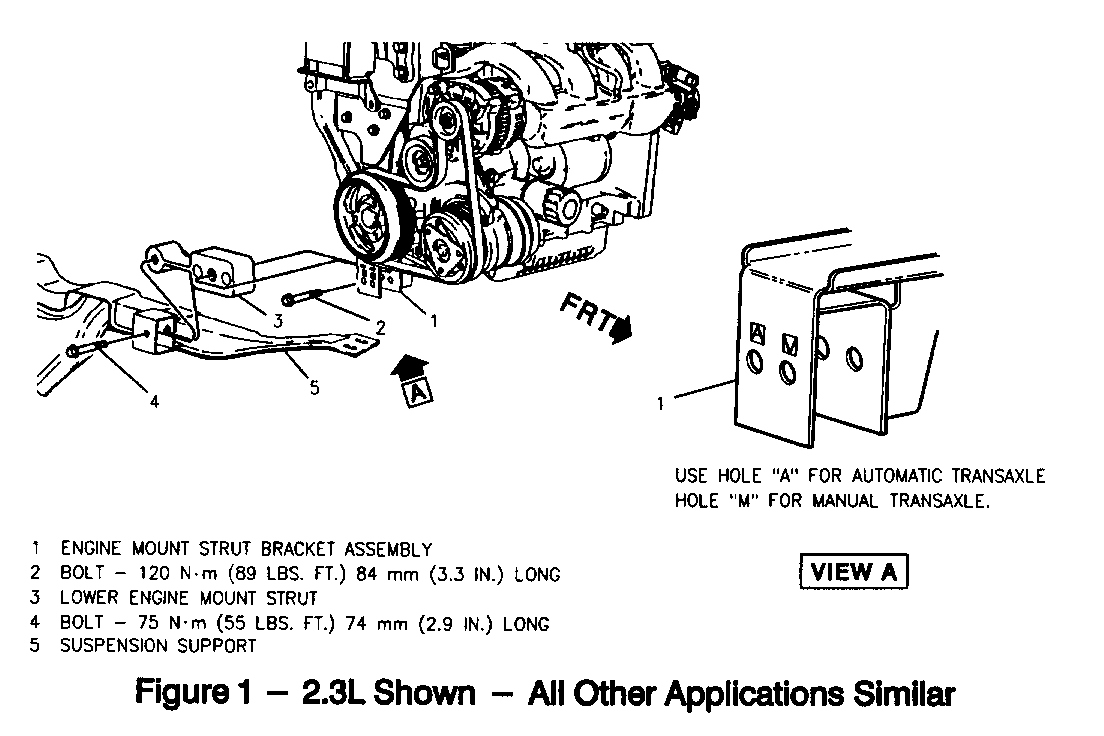GROWL,NOISE,EXHAUST NOISE COOLANT LEAK OR STEERING VIB.

SUBJECT: GROWL NOISE, EXHAUST NOISE, COOLANT LEAK OR STEERING WHEEL VIBRATION (REPLACE ENGINE MOUNT LOWER STRUT)
MODELS AFFECTED: 1992 GRAND AM MODELS
THIS BULLETIN IS BEING REVISED TO ADD "2.3L(VIN A,D,3)" TO SPECIFIC STATEMENTS OF TEXT, TO DELETE 2 INSPECTION STATEMENTS, AND TO CHANGE THE LABOR OPERATION NUMBER AND LABOR TIME ALLOWANCES. THIS BULLETIN CANCELS AND REPLACES BULLETIN 92-6-48 ISSUED 6192.
Condition:
---------- Some owners of 1992 Grand Am models may experience the following conditions:
1. Engine rocking more than normal back and forth in engine compartment during acceleration and deceleration.
2. Exhaust noise at the exhaust manifold seal during acceleration and deceleration.
3. Engine coolant leak from the radiator outlet hose, 2.3L (VIN A, D, 3).
4. Engine vibration felt through the steering wheel.
5. Growl or grounding out noise from the underhood area.
Cause:
------ Engine mount lower strut breaking from road shock, road debris impact or repeated rapid acceleration.
Correction:
----------- Replace engine mount lower strut.
Service Information:
- Refer to Section 6A7 for lower engine mount strut replacement.
- Be sure to inspect the following items. Some items may not apply to all vehicles.
- Engine cooling system for leaks.
- Radiator outlet hose for possible damage and/or leaks 2.3L (VIN A, D, 3).
- Drive axle boots for damage.
- Electrical wires and connections for damage.
- The strut to bracket bolt (5) is tightened to 120 N.m (89 lbs.ft.) and is longer than the strut to the suspension support bolt, which is tightened to 75 N.m (55 lbs.ft.). Use hole "A" for automatic transaxles and hole "M", for manual transaxles. Refer to illustration for correct fastener tightening specifications, bolt usage and bolt location.
Note: The 3.3L (VIN N) has only one hole in the engine mount strut assembly bracket. (Refer to Figure 1, item #1)
VIN BREAKPOINTS:
MODEL ENGINE TRANSAXLE VIN BREAKPOINT ----- ------ --------- -------------- Grand Am 2.3L (VIN D,3) Automatic NC236804/ NM050776
Grand Am 2.3L (VIN A) Manual NC237001
Grand Am 2.3L (VIN 3) Manual NC243142/ NM051566
Grand Am 3.3L (VIN N) Automatic NC236844/ NM050443
Parts Information:
Use the following New Part Numbers when replacing the Lower Engine Mount Strut:
MODEL ENGINE TRANSAXLE OLD P/N NEW P/N ----- ------ --------- ------- ------- Grand Am 2.3L (VIN D,3) Automatic 22112378 22113208 Grand Am 2.3L (VIN 3) Manual 22112379 22113209 Grand Am 2.3L (VIN A) Manual 22112730 22113211 Grand Am 3.3L (VIN N) Automatic 22112380 22113212
Parts are currently available from GMSPO.
Labor Operation Number: T1875
Labor Time : 0.5 Hours
Add: Lower Radiator Hose (VIN A,D,3) 0.4 Hours Add: Drive Axle Shaft Boots 0.7 Hours Add: Wire Repair 0.5 Hours

General Motors bulletins are intended for use by professional technicians, not a "do-it-yourselfer". They are written to inform those technicians of conditions that may occur on some vehicles, or to provide information that could assist in the proper service of a vehicle. Properly trained technicians have the equipment, tools, safety instructions and know-how to do a job properly and safely. If a condition is described, do not assume that the bulletin applies to your vehicle, or that your vehicle will have that condition. See a General Motors dealer servicing your brand of General Motors vehicle for information on whether your vehicle may benefit from the information.
